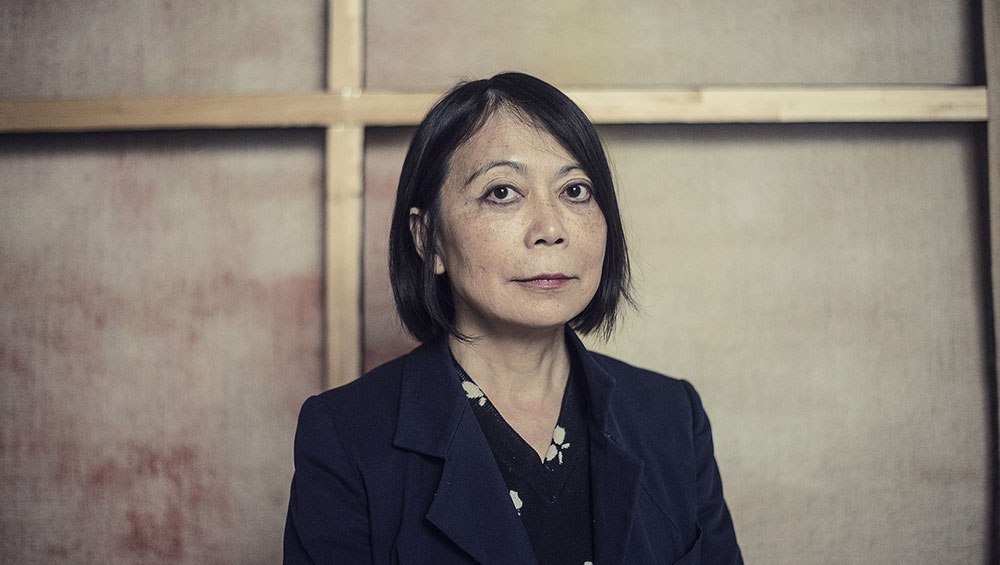
Leiko Ikemura. Photo: María Rúnarsdóttir.
by EMILY SPICER
The work of the Japanese-Swiss artist Leiko Ikemura (b1951) conjures a strange world, populated by impish girls rendered in paint, glass and clay. Girlhood is a time of transition, but these children are not growing into adults. Instead, they seem to belong to a timeless spirit realm. Some have long ears; others have tentacles. They are at once sturdy-looking and fragile, solemn and innocent. In clay, they crumble or disfigure themselves in acts of despair, plunging their serpentine arms into their eye sockets. The uncanny world these figures evoke is a melancholy one; death and grief stalk these beings. But there is hope, too, in the possibility of renewal. Green saplings grow from the side of a recumbent head of patinated bronze, and wispy landscapes with brightly coloured trees promise solace, even magic.
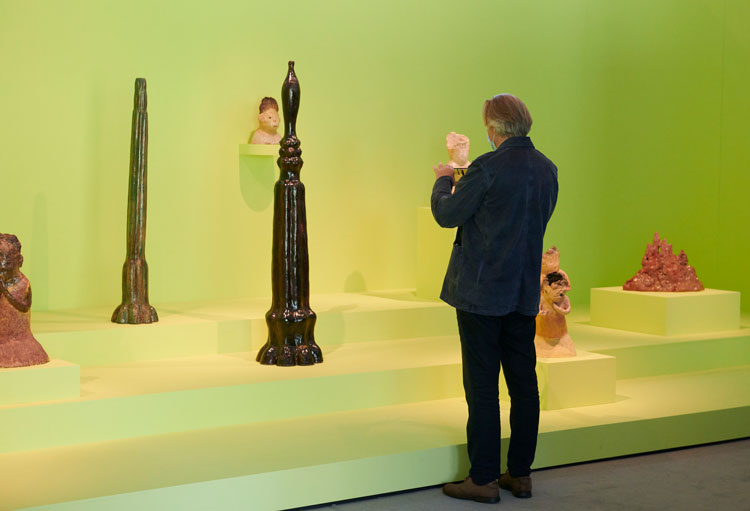
Leiko Ikemura: Usagi in Wonderland, installation view. Photo: Andi Sapey, Courtesy of the Sainsbury Centre.
Usagi in Wonderland is Ikemura’s first UK exhibition and includes work spanning three decades. She guided the installation at the Sainsbury Centre in Norwich via Zoom from her studio in Berlin, as Covid-19 travel restrictions prevented her from supervising in person. In the autumn, Ikemura’s bronze sculpture Usagi Kannon (Rabbit Bodhisattva of Mercy) will join the Sainsbury Centre’s sculpture park. It takes the form of an anthropomorphised rabbit with a bell-shaped skirt big enough for a person to shelter beneath. Ikemura created Usagi Kannon in response to the Tōhoku earthquake of 2011, which caused a devasting tsunami and triggered the nuclear disaster at the Fukushima Daiichi power plant.
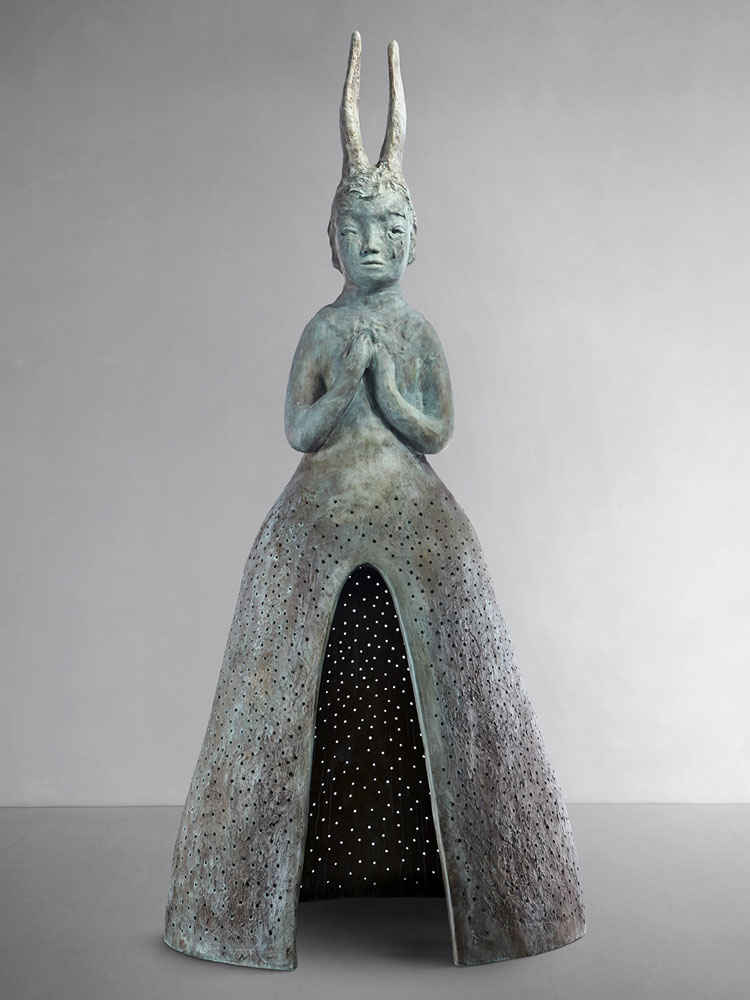
Leiko Ikemura. Usagi Kannon, 2012/19. Patinated bronze. Studio Ikemura, Berlin, Germany. Image © Leiko Ikemura and VG Bild-Kunst 2021. Photo Andreas Lange
Ikemura spoke to Studio International via Zoom from her Berlin studio.
Emily Spicer: Can you tell me about the exhibition title, Usagi in Wonderland?
Leiko Ikemura: Usagi means rabbit in Japanese, but not just an everyday rabbit, also a mystical being. I like the sound of this word. For me, the rabbit has many qualities and characteristics. There are stories from my childhood in which usagi was also in the moon. You can see a shadowy thing on the moon, and people would say, this is usagi, they are there and they are watching you. There are many nice stories. I feel very much connected to the usagi’s many meanings and the way they move with freedom. Also, the rabbit is very famous in European art history. There’s Albrecht Dürer’s rabbit, for example, and Joseph Beuys’ rabbit. They are connected to fertility in folklore and to the story of Alice in Wonderland. Our imagination is rich enough to guide us to other worlds. This is also a wish, a desire of mine, a message to the audience.
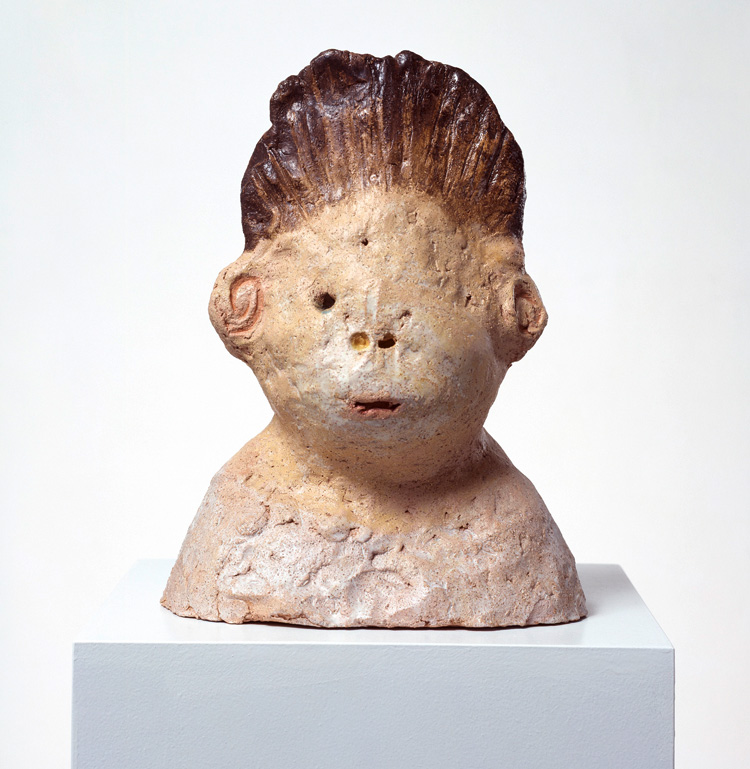
Leiko Ikemura. Single-Eyed Baby, 1994. Glazed terracotta. Studio Ikemura, Berlin, Germany. Image © Leiko Ikemura and VG Bild-Kunst 2021. Photo: Jochen Littkemann.
ES: This comes across in your art. There is a breaking down of boundaries between the human and the animal world.
LI: Yes, exactly. This freedom to go, to not be narrow-minded. It’s so important, I think, that we are jumping across borders. What are humans? Humans have a lot to do with animal life, with all the living forms.
ES: Does your work draw on any spiritual or religious beliefs?
LI: Not really. I think the spiritual is so important, but my ideas are not drawn from any specific religious group or ideology. It is more about the human condition. I think we need not only material welfare but also spiritual welfare, a way to experience, in a deeper sense, the questions we have, such as why we are here, where we are from and where we are going. They are simple questions, but nobody knows the answers. This is why art and religion could be so helpful. But I think these things should be individually pursued. Art can do that, somehow.
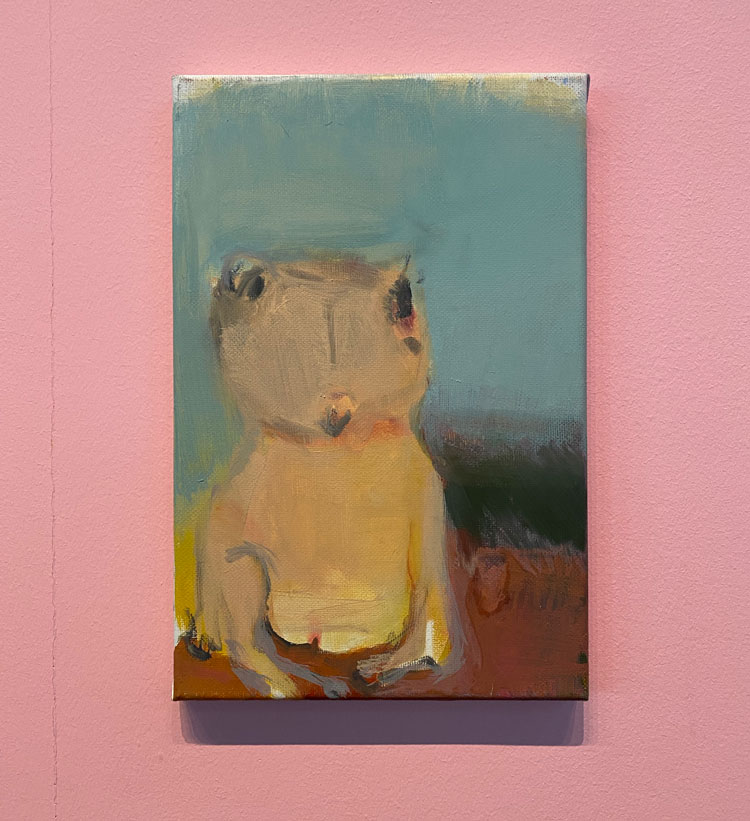
Leiko Ikemura. Moo, 1993. Oil and tempera on canvas. Installation view, Leiko Ikemura: Usagi in Wonderland, Sainsbury Centre, UEA, Norwich. Photo: Martin Kennedy.
ES: Some of your figures look as though they are sleeping, others look as though they may have passed away, or as if they are ghosts. Do these artworks speak of your own personal feelings about death and grief, or is it more an exploration into the possibilities?
LI: Death is our fate and we are confronted with the loss of relatives and friends. I think it is very hard. Also, when there is a collective disaster, such as the 2011 Tōhoku earthquake 10 years ago, the grief is collective, so I needed to visualise how I could express that without being too sentimental. Tōhoku was a collective shock, like 9/11. Sometimes these tragic events happen, and we have to deal with them and it is not easy. Especially as an artist, what can you do?

Leiko Ikemura. Memento Mori, 2013-18. Patinated bronze. Installation view, Leiko Ikemura: Usagi in Wonderland, Sainsbury Centre, UEA, Norwich. Photo: Martin Kennedy.
ES: You have travelled a lot in your life. You were born in Japan and have lived in Spain, Switzerland and Germany. Has travelling influenced your work?
LI: Yes, I think a lot. Of course, due to Covid-19, I haven’t travelled much these past two years. But it was also a very interesting experience, and we maybe travel – generally speaking – too much. But, on the other hand, travelling is also inspirational. I learn a lot. So, I think it influences my work. I can’t always say, this element is from Spain, or this one is from Switzerland, or Germany. It’s a very hybrid thing. It’s a mixture of everything. And people say, oh, this looks a bit Japanese, and I say, well, it’s possible, you know, why not? Because it’s a part of me.
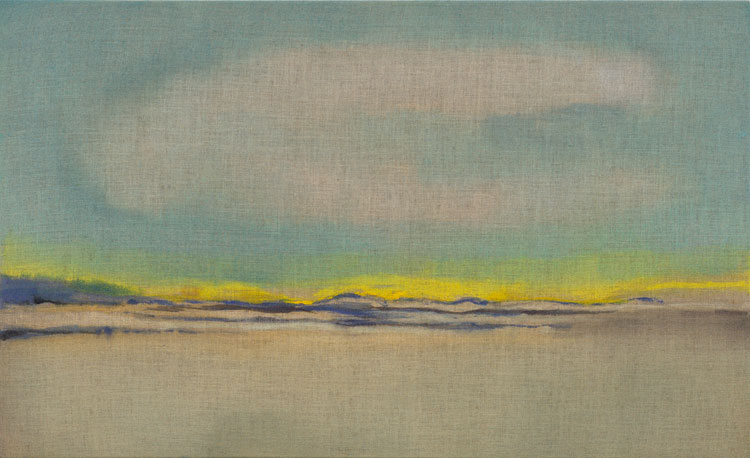
Leiko Ikemura. Berlin Horizon I, 2012. Tempera and oil on jute. Studio Ikemura, Berlin, Germany. Image © Leiko Ikemura and VG Bild-Kunst 2021. Photo: Jörg von Bruchhause.
ES: I am really interested in your landscapes. Some of them are quite fantastical, some of them have an eerie glow. Do they offer up some alternative world, or an alternative future? Or are they simply an expression of places you have seen?
LI: They are not specifically places I have been, but I’m often in Switzerland, so there are certain landscapes that are deeply in my mind. For example, I like the fundamental geographical elements, such as the mountains and the lakes. I’m very interested in lakes and water and how water mirrors the sky. I think it is a universal landscape and I am also influenced by landscapes I know and have experienced. I have the feeling that there’s a kind of prototype that we might think about. But, for me, it’s also a vision, a kind of mindscape.
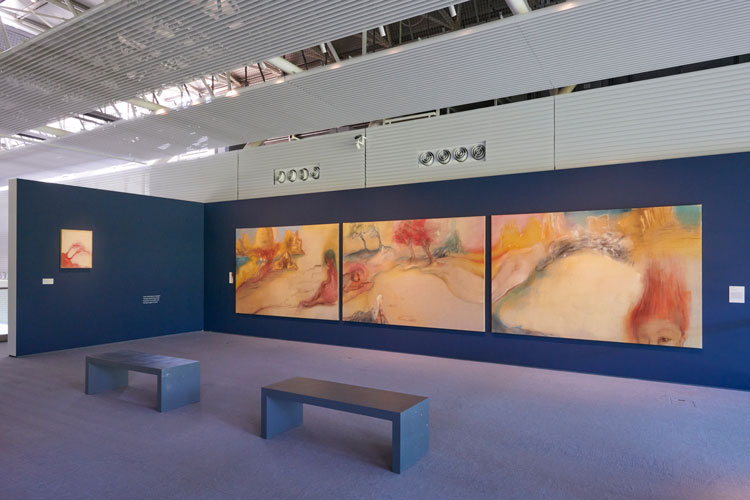
Leiko Ikemura: Usagi in Wonderland, installation view. Photo: Andi Sapey, Courtesy of the Sainsbury Centre.
I think we have this inner life, and this inner life has a kind of physiognomy. It is your imagination, but your imagination is always part of your life. It’s like a dream. I like the idea of daydreams. But also, it has to do with your body because, when I work, it is like a dance. If you just act unconsciously, you do curves and lines. I hope you can try it one day! You suddenly see mountains and a lake. This very childlike playfulness is like you are watching the sky and the clouds. And sometimes you say, this looks like a lion, this looks like an otter or the mountains that I know. So, I start by making very abstract forms. The canvas tells me what to do next.
ES: Your method is quite intuitive?
LI: Exactly, yes. But it is also a kind of meditation, because I concentrate on myself, what is in my mind, what is going on. It is a very important process.
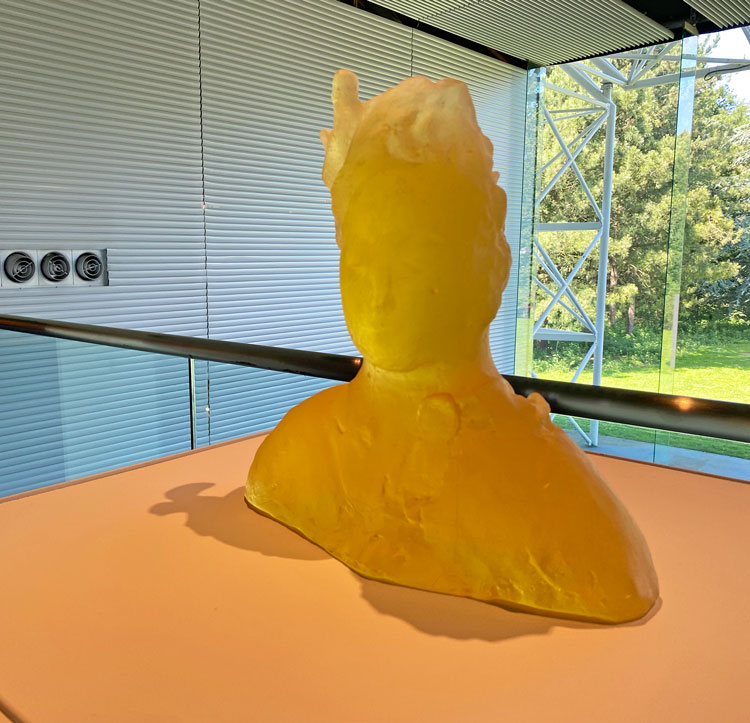
Leiko Ikemura. Yellow Figure with Hummingbird, 2020. Cast glass. Studio Ikemura, Berlin, Germany. Installation view, Leiko Ikemura: Usagi in Wonderland, Sainsbury Centre, UEA, Norwich. Photo: Martin Kennedy.
ES: Talking about the practicalities of how you work, you recently started working with glass for the first time. What prompted your move into glasswork, and how have you found it? I know there have been some difficulties during lockdown.
LI: I was invited to work in Murano in Venice, which is famous for its glass. I visited years ago, and since then I have been fascinated. With ceramics, which I have been making for years, the surface is glass, that’s why we say it has a glaze. So, in a way, I have been dealing with that element for years. But this was the first time I dealt simply with glass. I was very excited, expecting to work there for a month. But then the pandemic hit, and I could not travel. I was very sad, but I was lucky enough to find somebody to assist me, a good artist with lots of experience with glass. For me, it is really exciting. When the light comes through a glass object, it’s amazing. I’m always critical with my work, but with the glass I’m so delighted. Every time I opened the kiln, it’s like finding treasure. But it takes a long time, and it is not such an easy thing.

Leiko Ikemura. Cat, 2020. Cast glass. Studio Ikemura, Berlin, Germany. Installation view, Leiko Ikemura: Usagi in Wonderland, Sainsbury Centre, UEA, Norwich. Photo: Martin Kennedy.
LI: In a way, that makes the product even more special because of all the effort and time and risk that goes into it.
LI: It is more difficult, I would say, than ceramics. With ceramics, there is seldom an accident, but with glass many, many things can happen. It’s not always perfect, or maybe never perfect, but this is what I like. The balance is important. That’s what attracts me. And I like the pureness of the colour and the transparency. That fascinates me.
ES: And it is forever changing with the light.
LI: Exactly. The light is changing, so it is changing all the time, and this is unique. With a glass object, you feel this magic something. You can’t grasp it, you can’t see why, but you feel this uncertainty. There is something mysterious about it.
• Leiko Ikemura: Usagi in Wonderland is at the Sainsbury Centre, Norwich, until 12 December 2021.